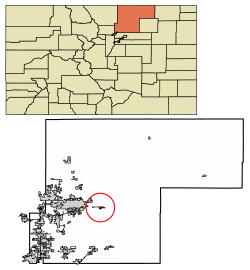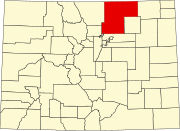Kersey, Colorado
Town of Kersey, Colorado | |
|---|---|
Statutory Town | |
 | |
 Location of Kersey in Weld County, Colorado. | |
| Coordinates: 40°23′10″N 104°33′41″W / 40.38611°N 104.56139°WCoordinates: 40°23′10″N 104°33′41″W / 40.38611°N 104.56139°W | |
| Country | |
| State | |
| County[1] | Weld |
| Incorporated (town) | December 3, 1908[2] |
| Government | |
| • Type | Statutory Town[1] |
| Area | |
| • Total | 2.03 sq mi (5.25 km2) |
| • Land | 2.02 sq mi (5.24 km2) |
| • Water | 0.01 sq mi (0.01 km2) |
| Elevation | 4,619 ft (1,408 m) |
| Population (2010) | |
| • Total | 1,454 |
| • Estimate (2019)[5] | 1,681 |
| • Density | 831.36/sq mi (321.04/km2) |
| Time zone | UTC-7 (Mountain (MST)) |
| • Summer (DST) | UTC-6 (MDT) |
| ZIP code[6] | 80644 |
| Area code(s) | 970 |
| FIPS code | 08-40515 |
| GNIS feature ID | 0204695 |
| Website | www |
The Town of Kersey is a Statutory Town in Weld County, Colorado, United States. The population was 1454 at the 2010 United States Census.
History[]
Elbridge Gerry established a trading post called Fort Gerry on the South Platte River near the present-day town of Kersey, Colorado in the 1830s. He had two Native American wives who helped him run the post. In 1840, Gerry abandoned the site and built a post on the south bank of the river.[7][8] Gerry is said to be the first white man to settle in what is now Weld County.[9]
A post office called Kersey has been in operation since 1894.[10] A railroad official gave Kersey the maiden name of his mother.[11]
Geography[]
Kersey is located at 40°23′10″N 104°33′41″W / 40.38611°N 104.56139°W (40.386060, -104.561453).[12]
According to the United States Census Bureau, the town has a total area of 1.0 square mile (2.6 km2), all of it land.
Demographics[]
| Historical population | |||
|---|---|---|---|
| Census | Pop. | %± | |
| 1910 | 304 | — | |
| 1920 | 319 | 4.9% | |
| 1930 | 307 | −3.8% | |
| 1940 | 268 | −12.7% | |
| 1950 | 304 | 13.4% | |
| 1960 | 378 | 24.3% | |
| 1970 | 474 | 25.4% | |
| 1980 | 913 | 92.6% | |
| 1990 | 863 | −5.5% | |
| 2000 | 1,406 | 62.9% | |
| 2010 | 1,454 | 3.4% | |
| 2019 (est.) | 1,681 | [5] | 15.6% |
| U.S. Decennial Census[13] | |||
As of the census[14] of 2000, there were 1,389 people, 474 households, and 374 families residing in the town. The population density was 1,425.8 people per square mile (552.9/km2). There were 489 housing units at an average density of 502.0 per square mile (194.6/km2). The racial makeup of the town was 91.43% White, 0.07% African American, 0.29% Native American, 0.79% Asian, 4.75% from other races, and 2.66% from two or more races. Hispanic or Latino of any race were 20.01% of the population.
There were 474 households, out of which 48.1% had children under the age of 18 living with them, 62.4% were married couples living together, 12.2% had a female householder with no husband present, and 20.9% were non-families. 17.1% of all households were made up of individuals, and 7.8% had someone living alone who was 65 years of age or older. The average household size was 2.93 and the average family size was 3.33.
In the town, the population was spread out, with 34.5% under the age of 18, 8.3% from 18 to 24, 31.0% from 25 to 44, 18.0% from 45 to 64, and 8.2% who were 65 years of age or older. The median age was 30 years. For every 100 females, there were 96.2 males. For every 100 females age 18 and over, there were 92.0 males.
The median income for a household in the town was $41,333, and the median income for a family was $45,329. Males had a median income of $31,250 versus $23,148 for females. The per capita income for the town was $16,346. About 8.1% of families and 8.9% of the population were below the poverty line, including 10.6% of those under age 18 and 6.1% of those age 65 or over.
See also[]
- Outline of Colorado
- Index of Colorado-related articles
- Greeley, CO Metropolitan Statistical Area
References[]
- ^ a b "Active Colorado Municipalities". State of Colorado, Department of Local Affairs. Archived from the original on 2009-12-12. Retrieved 2007-09-01.
- ^ "Colorado Municipal Incorporations". State of Colorado, Department of Personnel & Administration, Colorado State Archives. 2004-12-01. Retrieved 2007-09-02.
- ^ "2019 U.S. Gazetteer Files". United States Census Bureau. Retrieved July 1, 2020.
- ^ "US Board on Geographic Names". United States Geological Survey. 2007-10-25. Retrieved 2008-01-31.
- ^ a b "Population and Housing Unit Estimates". United States Census Bureau. May 24, 2020. Retrieved May 27, 2020.
- ^ "ZIP Code Lookup". United States Postal Service. Archived from the original (JavaScript/HTML) on November 4, 2010. Retrieved October 18, 2007.
- ^ Phil Payette; Pete Payette. "Colorado forts - Fort Huerfano". American Forts Network. Retrieved June 6, 2018.
- ^ Pick-Sloan Missouri Basin Program, Narrows Unit: Environmental Impact Statement. 1976. p. 17.
- ^ Sarah Arnusch (2014). Evans. Arcadia Publishing. pp. 14–. ISBN 978-1-4671-3121-6.
- ^ "Post offices". Jim Forte Postal History. Retrieved 29 June 2016.
- ^ Dawson, John Frank. Place names in Colorado: why 700 communities were so named, 150 of Spanish or Indian origin. Denver, CO: The J. Frank Dawson Publishing Co. p. 29.
- ^ "US Gazetteer files: 2010, 2000, and 1990". United States Census Bureau. 2011-02-12. Retrieved 2011-04-23.
- ^ "Census of Population and Housing". Census.gov. Retrieved June 4, 2015.
- ^ "U.S. Census website". United States Census Bureau. Retrieved 2008-01-31.
External links[]
- Towns in Weld County, Colorado
- Towns in Colorado

